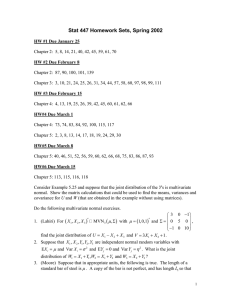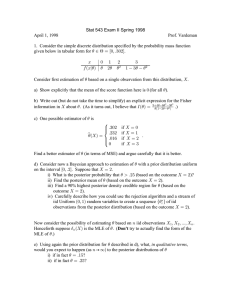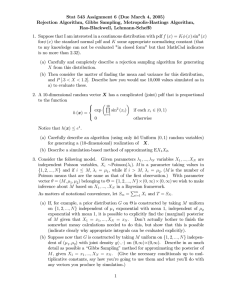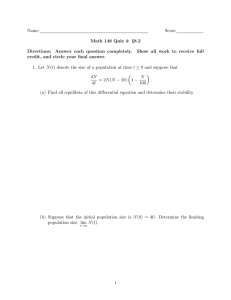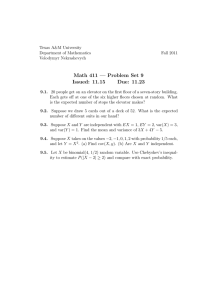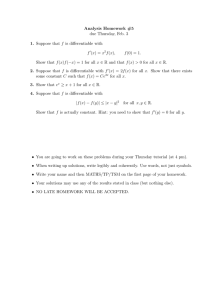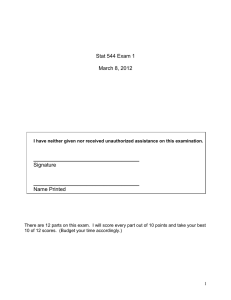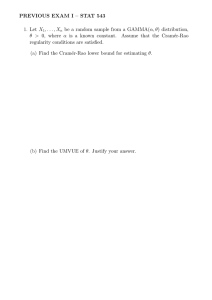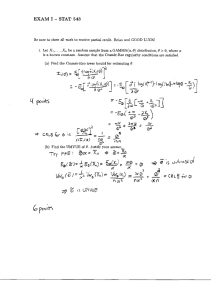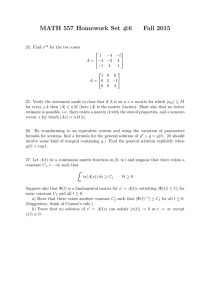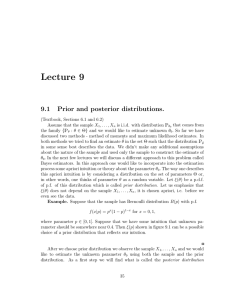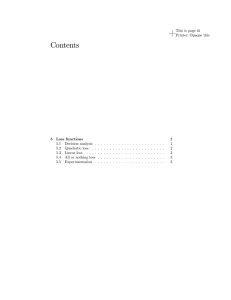Stat 447 Homework Sets, Spring 2002
advertisement
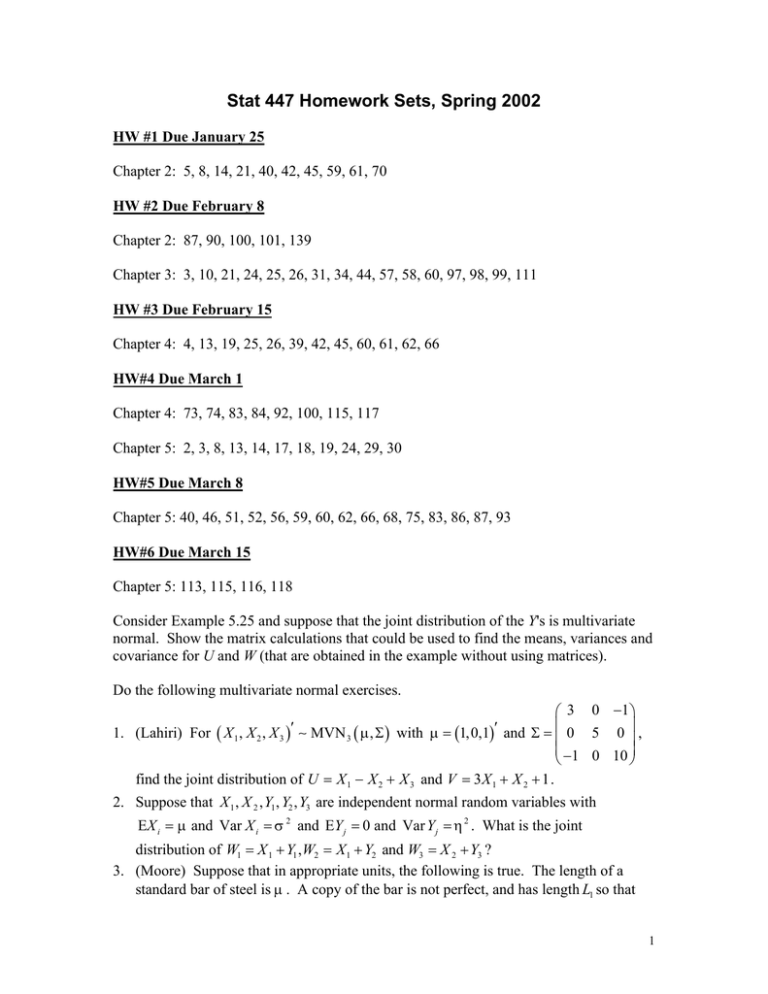
Stat 447 Homework Sets, Spring 2002 HW #1 Due January 25 Chapter 2: 5, 8, 14, 21, 40, 42, 45, 59, 61, 70 HW #2 Due February 8 Chapter 2: 87, 90, 100, 101, 139 Chapter 3: 3, 10, 21, 24, 25, 26, 31, 34, 44, 57, 58, 60, 97, 98, 99, 111 HW #3 Due February 15 Chapter 4: 4, 13, 19, 25, 26, 39, 42, 45, 60, 61, 62, 66 HW#4 Due March 1 Chapter 4: 73, 74, 83, 84, 92, 100, 115, 117 Chapter 5: 2, 3, 8, 13, 14, 17, 18, 19, 24, 29, 30 HW#5 Due March 8 Chapter 5: 40, 46, 51, 52, 56, 59, 60, 62, 66, 68, 75, 83, 86, 87, 93 HW#6 Due March 15 Chapter 5: 113, 115, 116, 118 Consider Example 5.25 and suppose that the joint distribution of the Y's is multivariate normal. Show the matrix calculations that could be used to find the means, variances and covariance for U and W (that are obtained in the example without using matrices). Do the following multivariate normal exercises. 3 0 −1 1. (Lahiri) For ( X 1 , X 2 , X 3 )′ : MVN 3 ( µ , Σ ) with µ = (1,0,1)′ and Σ = 0 5 0 , −1 0 10 find the joint distribution of U = X 1 − X 2 + X 3 and V = 3 X 1 + X 2 + 1 . 2. Suppose that X 1 , X 2 , Y1, Y2 , Y3 are independent normal random variables with EX i = µ and Var X i = σ 2 and EY j = 0 and Var Y j = η 2 . What is the joint distribution of W1 = X 1 + Y1 ,W2 = X 1 + Y2 and W3 = X 2 + Y3 ? 3. (Moore) Suppose that in appropriate units, the following is true. The length of a standard bar of steel is µ . A copy of the bar is not perfect, and has length L1 so that 1 D1 = L1 − µ ~ N ( 0,1) . A copy of this copy has length L2 so that D2 = L2 − L1 ~ N ( 0,1) and D2 is independent of L1 . A copy of the copy of the copy has length L3 so that D3 = L3 − L2 ~ N ( 0,1) and D3 is independent of L1 and L2 . a) What is the (joint) distribution of L = ( L1 , L2 , L3 ) ? b) Evaluate the correlation between L1 and L3 . c) What is the distribution of L3 − µ , the error in length of the last bar? HW#7 Due March 29 Chapter 6: 1, 2, 6, 9, 11, 19, 25, 26, 60, 61, 65, 68 HW#8 Due April 12 Chapter 7: 3, 4, 7, 8, 11, 15, 18, 21, 25, 26, 27, 42, 75 Chapter 8: 4, 10, 12 HW#9 Due April 26 Chapter 8: 19, 33, 40, 41, 44, 45, 47, 58, 59, 69, 70, 76, 81, 82, 110 Chapter 9:76 abc, 80 HW#10 Not to be Collected (But to be Examined on the Final) 1. Suppose that X 1 , X 2 ,..., X n are iid Geometric ( p ) . a) Write out the likelihood function, L( p ) and its natural logarithm, l ( p ) . Then find d the score function, l ′( p ) = l ( p ) . Set the score function equal to 0 and solve for a dp maximum likelihood estimator of p. (To be absolutely precise, you should treat separately the case that all X i take the value 0.) 1 . Based on l ′′( pˆ ) this, what would you report as an approximate 95% confidence interval for p? c) Find the method of moments estimator for p. Is it different from the MLE? d) Suppose now that one takes a Bayes view of inference in this problem and uses a Beta (α , β ) prior distribution for p. Call the prior probability density g ( p ) . The b) Find a standard error for your estimator in a) by finding σˆ pˆ = − product L( p ) g ( p ) (which is proportional to the posterior density of p given the observed values of X 1 , X 2 ,..., X n ) can be recognized as having what standard form? What are then the mean and variance of the posterior distribution? For large n , do 2 you expect the posterior distribution to be concentrated "near the true value of p"? Why? 2. Suppose that X 1 , X 2 ,..., X n are iid Poisson ( λ ) and that that one takes a Bayes view of inference for λ . Further suppose one uses an Exponential ( β ) prior distribution for λ . The product L(λ ) g (λ ) (which is proportional to the posterior density of λ given the observed values of X 1 , X 2 ,..., X n ) can be recognized as having what standard form? What are then the mean and variance of the posterior distribution? For large n , do you expect the posterior distribution to be concentrated "near the true value of λ "? Why? Chapter 10: 2, 3, 7, 11, 15, 17, 22, 35, 37, 51, 57, 73, 74 (Also find p-values in Exercises 7, 11, 15, 17, and say what you can about the size of the p-values in 51, 57, 73, 74) Chapter 11: 4, 14, 29, 33, 41 3
